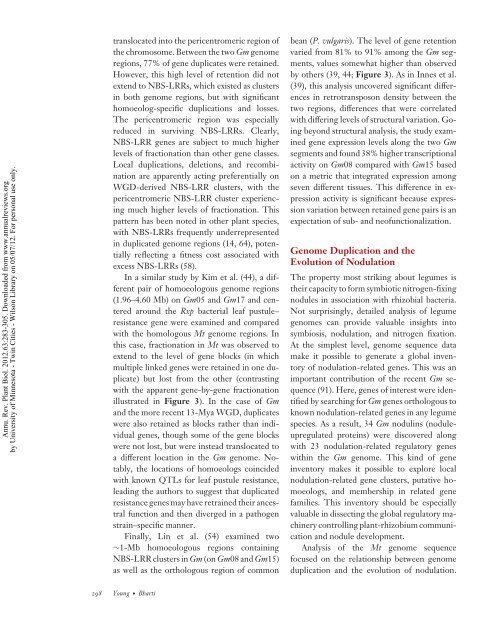Genome-Enabled Insights into Legume Biology - University of ...
Genome-Enabled Insights into Legume Biology - University of ...
Genome-Enabled Insights into Legume Biology - University of ...
Create successful ePaper yourself
Turn your PDF publications into a flip-book with our unique Google optimized e-Paper software.
Annu. Rev. Plant Biol. 2012.63:283-305. Downloaded from www.annualreviews.org<br />
by <strong>University</strong> <strong>of</strong> Minnesota - Twin Cities - Wilson Library on 05/07/12. For personal use only.<br />
translocated <strong>into</strong> the pericentromeric region <strong>of</strong><br />
the chromosome. Between the two Gm genome<br />
regions, 77% <strong>of</strong> gene duplicates were retained.<br />
However, this high level <strong>of</strong> retention did not<br />
extend to NBS-LRRs, which existed as clusters<br />
in both genome regions, but with significant<br />
homoeolog-specific duplications and losses.<br />
The pericentromeric region was especially<br />
reduced in surviving NBS-LRRs. Clearly,<br />
NBS-LRR genes are subject to much higher<br />
levels <strong>of</strong> fractionation than other gene classes.<br />
Local duplications, deletions, and recombination<br />
are apparently acting preferentially on<br />
WGD-derived NBS-LRR clusters, with the<br />
pericentromeric NBS-LRR cluster experiencing<br />
much higher levels <strong>of</strong> fractionation. This<br />
pattern has been noted in other plant species,<br />
with NBS-LRRs frequently underrepresented<br />
in duplicated genome regions (14, 64), potentially<br />
reflecting a fitness cost associated with<br />
excess NBS-LRRs (58).<br />
In a similar study by Kim et al. (44), a different<br />
pair <strong>of</strong> homoeologous genome regions<br />
(1.96–4.60 Mb) on Gm05 and Gm17 and centeredaroundtheRxp<br />
bacterial leaf pustule–<br />
resistance gene were examined and compared<br />
with the homologous Mt genome regions. In<br />
this case, fractionation in Mt was observed to<br />
extend to the level <strong>of</strong> gene blocks (in which<br />
multiple linked genes were retained in one duplicate)<br />
but lost from the other (contrasting<br />
with the apparent gene-by-gene fractionation<br />
illustrated in Figure 3). In the case <strong>of</strong> Gm<br />
and the more recent 13-Mya WGD, duplicates<br />
were also retained as blocks rather than individual<br />
genes, though some <strong>of</strong> the gene blocks<br />
were not lost, but were instead translocated to<br />
a different location in the Gm genome. Notably,<br />
the locations <strong>of</strong> homoeologs coincided<br />
with known QTLs for leaf pustule resistance,<br />
leading the authors to suggest that duplicated<br />
resistance genes may have retrained their ancestral<br />
function and then diverged in a pathogen<br />
strain–specific manner.<br />
Finally, Lin et al. (54) examined two<br />
∼1-Mb homoeologous regions containing<br />
NBS-LRR clusters in Gm (on Gm08 and Gm15)<br />
as well as the orthologous region <strong>of</strong> common<br />
bean (P. vulgaris). The level <strong>of</strong> gene retention<br />
varied from 81% to 91% among the Gm segments,<br />
values somewhat higher than observed<br />
by others (39, 44; Figure 3). As in Innes et al.<br />
(39), this analysis uncovered significant differences<br />
in retrotransposon density between the<br />
two regions, differences that were correlated<br />
with differing levels <strong>of</strong> structural variation. Going<br />
beyond structural analysis, the study examined<br />
gene expression levels along the two Gm<br />
segments and found 38% higher transcriptional<br />
activity on Gm08 compared with Gm15 based<br />
on a metric that integrated expression among<br />
seven different tissues. This difference in expression<br />
activity is significant because expression<br />
variation between retained gene pairs is an<br />
expectation <strong>of</strong> sub- and ne<strong>of</strong>unctionalization.<br />
<strong>Genome</strong> Duplication and the<br />
Evolution <strong>of</strong> Nodulation<br />
The property most striking about legumes is<br />
their capacity to form symbiotic nitrogen-fixing<br />
nodules in association with rhizobial bacteria.<br />
Not surprisingly, detailed analysis <strong>of</strong> legume<br />
genomes can provide valuable insights <strong>into</strong><br />
symbiosis, nodulation, and nitrogen fixation.<br />
At the simplest level, genome sequence data<br />
make it possible to generate a global inventory<br />
<strong>of</strong> nodulation-related genes. This was an<br />
important contribution <strong>of</strong> the recent Gm sequence<br />
(91). Here, genes <strong>of</strong> interest were identified<br />
by searching for Gm genes orthologous to<br />
known nodulation-related genes in any legume<br />
species. As a result, 34 Gm nodulins (noduleupregulated<br />
proteins) were discovered along<br />
with 23 nodulation-related regulatory genes<br />
within the Gm genome. This kind <strong>of</strong> gene<br />
inventory makes it possible to explore local<br />
nodulation-related gene clusters, putative homoeologs,<br />
and membership in related gene<br />
families. This inventory should be especially<br />
valuable in dissecting the global regulatory machinery<br />
controlling plant-rhizobium communication<br />
and nodule development.<br />
Analysis <strong>of</strong> the Mt genome sequence<br />
focused on the relationship between genome<br />
duplication and the evolution <strong>of</strong> nodulation.<br />
298 Young·Bharti

















